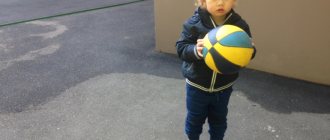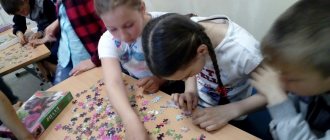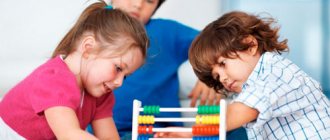Individual approach and team work with children
Each child is instilled with the ability to feel a balance between collective activities with a teacher and the manifestation of their own individuality. The whole group receives a given topic, but everyone completes this task in their own way.
Conducting GCD on drawing on a chosen topic
- A selection of demonstration materials for the conversation (photos and drawings) form the basis of the visual aid for the lesson. Such pictures should be selected taking into account the age of the children. The image should be clear, three-dimensional, moderately bright, understandable for children, and not difficult to reproduce.
- Music and poetry appropriate to the topic of the lesson will help create a favorable background and creative atmosphere. They are also selected taking into account age characteristics. The positive influence of classical instrumental music, such as Bach or Beethoven, has been proven. Thematic children's songs about the depicted object are also perfect for a subject image.
- The lesson notes on drawing in the chosen technique for different age groups are prepared by the teacher in advance.
Drawing “Icicles are crying” - spring theme for younger groups
| Age group | Subject | Method and technique | Materials |
| 2-3 years, junior group | Apple | Dot drawing with a cotton swab. | Watercolor or gouache, cotton swabs, thick paper or cardboard with the outline of an apple. A jar of water, 3/4 full. |
| 3-4 years old, second youngest group. | Blooming spring tree | Graphics with colored pencils. | Set of colored pencils: pink, green, brown. Paper or cardboard. |
| 4-5 years old, middle group. | Autumn kindergarten. | Watercolor | A set of watercolor paints 10-12 colors, paper or cardboard, 2-3 small or medium sized squirrel brushes, a jar of water. |
| 5-6 years old, preparatory group | Undersea world | Application. Using stencils, drawings are drawn onto paper with a simple pencil, then they are cut out and pasted onto a background sheet. | Base - turquoise colored cardboard, PVA glue, hard glue brush, glass of water, a set of colored paper or cardboard of different colors, scissors, stencils (clams, shells, starfish, fish, octopuses, etc.), a simple pencil . |
How to get your child interested in drawing
Absolutely all children, learning about the world around them, do this through the act of creativity. The psyche of a baby from birth is like a blank slate, but personality and temperament are already innate. Therefore, parents need to try to understand the individuality of their child and contribute as much as possible to the disclosure of his inner potential without unnecessary pressure and neglect.
On a note! To do this, it is not at all necessary to compete with each other in the number of developmental activities, courses and clubs, but to provide the child with space and material for creativity as early as possible, studying with him.
Where to begin:
- Starting from six to seven months, when the baby has already begun to sit confidently, you can give him an album and finger paints, soft wax crayons, modeling dough, and so on. Water coloring pages are also suitable.
- Bright, but not acidic colors and ease of use will immediately attract the little creator for at least a few minutes, or maybe even an hour. This will be enough for daily activities; they also contribute to the development of concentration and perseverance. In addition to special techniques with various cards and bags, each mother can independently find a lot of ways to expand the boundaries of perception and encourage her baby to be creative with the help of available tools, helping and supporting. Co-creation is the basis for closer, trusting relationships in the future.
- Creator's Kit. The simultaneous perception of color and shape, the skills of holding a pencil or brush in your hand, drawing, sculpting - all this creates new neural connections, and regular repetitions strengthen them.
- It is ideal to interest a child by personal example, when one of the parents, an older brother or sister draws.
- Collective creativity that develops drawing in children in kindergarten.
- However, if a child shows no interest in drawing at all, but prefers more active actions, then there is no need to force him, it will only have the opposite effect. Such children should be periodically offered drawing unobtrusively.
Conditions and means
Important! All creative materials for children under three years of age should be as safe and non-toxic as possible. They need to be bought in special stores from responsible manufacturers, or made with your own hands from food products (flour, water, salt, fruit juices, etc. There are a lot of recipes on the Internet!)
Such classes are held at home in a comfortable environment under the supervision of adults. During teething, you can exclude them, or use special products that relieve itching of the gums so that the child does not eat paints and crayons.
What does fine art give and develop in a preschooler?
At the age of three, there is a leap in brain development, as well as the autonomy of the little person’s consciousness from his parents. During this period, it is very important to promote independence and creativity. At the same time, a crisis at the age of three is possible, when a child rebels and protests against literally everything. Engaging in creative activities will help you get through this period easier. And in the future it contributes to the formation of a comprehensively developed personality.
Children's projects on traffic rules in kindergartens in accordance with the Federal State Educational Standard
Drawing
One of the types of visual activity is drawing (subject, subject, decorative).
Subject drawing
In the subject drawing of preschool children, the main attention should be paid to developing the ability to explore an object, depict it using lines, color spots, compositional arrangement, conveying characteristic features, proportions, and structure in the created image.
Particular importance should be attached to sensory development: to train the child in distinguishing colors, in determining the shape and size of objects. A variety of educational and educational games will help with this.
Subject drawing
In plot drawing, attention should be paid to the development of the concept, filling it with specific figurative content. When creating simple thematic compositions, the child must comprehend the logical connection of the depicted objects with each other.
It is this type of drawing that helps a child learn to draw from life, from imagination, from memory, from the content of a work, to create simple multifaceted compositions, and promotes the development of associative thinking.
The teacher must provide the child with the opportunity to realize his fantasies both in individual and in collective plot-thematic drawings.
Decorative drawing
Decorative drawing helps to deepen a preschooler’s knowledge about folk crafts (pottery, embroidery, carpet weaving, painting), and fosters interest in the culture of his native people. The teacher should encourage children to create simple patterns from familiar elements on various planar forms, and practice rhythmically performing patterns with traditional color combinations.
Drawing Tools
The characteristic means of expressiveness of all types of drawing are a point, a line, a spot, color, shape, proportions, composition, a rhythmic combination of drawing elements, and the like. With their help, a child can create images of both real and imaginary, fictional objects.
Modeling
The uniqueness of modeling as one of the main types of visual activity lies in the possibility of creating a three-dimensional image. Thanks to the special plasticity of materials (clay, plasticine, dough), the child very quickly masters the skills of conveying the structure, spatial thinking, and dynamics of movement of the depicted object.
The main means of creating an image in sculpting is the transfer of a three-dimensional form. We also recommend using color, especially when coloring hand-made folk toys.
Application
Application as a type of activity differs from others in the already existing forms of various objects, their parts, which do not need to be created or drawn. The main task in applique for preschoolers is to correctly place and stick the finished elements, thus recreating a decorative pattern or a certain image.
Applique classes contribute to the development of a sense of color, rhythm, symmetry, spatial orientation on a sheet and the formation of the first aesthetic tastes. During the course of work, the teacher should pay special attention to instilling organization in children. After all, creating an application requires a clear sequence of actions.
In order to enhance the manifestations of artistic creativity, we advise you to involve children in the production of individual and. collective works through the creation of images of objects of the surrounding reality through a harmonious combination of the various above-mentioned types of visual activities, materials (paper with clay, plasticine with natural materials) or techniques (appliqué from torn paper and palm painting) and the like.
Preschoolers really like this integration and contribute to the search for new interesting solutions in creating already familiar images.





